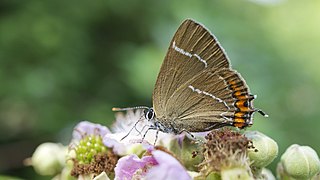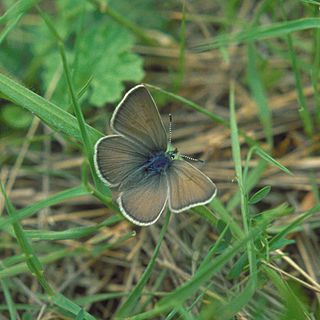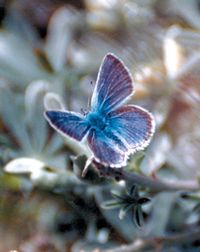
Lycaenidae is the second-largest family of butterflies, with over 6,000 species worldwide, whose members are also called gossamer-winged butterflies. They constitute about 30% of the known butterfly species.

The great purple hairstreak, also called the great blue hairstreak, is a common gossamer-winged butterfly species in parts of the United States. It is actually a Neotropical species; its North American range only includes the warm-temperate and subtropical parts of that continent, and it ranges southwards almost to the Isthmus of Panama. The type specimen, however, was shipped to Europe from the Colony of Virginia, probably around the time of the United States Declaration of Independence.

The white-letter hairstreak is a butterfly in the family Lycaenidae.

Eriogonum fasciculatum is a species of wild buckwheat known by the common names California buckwheat and eastern Mojave buckwheat.

Fender's blue butterfly is an endangered subspecies of butterfly endemic to the Willamette Valley of northwestern Oregon, United States. The subspecies was first documented in the 1920s and was described to science in 1931 by biologist Ralph Macy. He named it for his friend, Kenneth Fender, an entomologist and mail carrier. The subspecies was not seen after the 1930s and was presumed extinct. Small populations were rediscovered in 1989. Its eponym, Fender, had died nine years earlier. In January 2000, Fender's blue butterfly was added to the Endangered Species List by the U.S. Fish and Wildlife Service. The largest known populations now exist in the Baskett Slough National Wildlife Refuge. A 2014 study reintroduced this subspecies to William L. Finley National Wildlife Refuge. The potential range of the butterfly extends from south and west of Portland, OR to south of Eugene, OR.

The Mission blue is a blue or lycaenid butterfly subspecies native to the San Francisco Bay Area of the United States. The butterfly has been declared as endangered by the US federal government. It is a subspecies of Boisduval's blue.

The genus Satyrium contains butterflies in the family Lycaenidae. The species of this genus are found in the Holarctic ecozone. For distribution information see Further reading "Le genre Satyrium".

Lupinus perennis is a flowering plant in the family Fabaceae. It is widespread in the eastern part of the USA and Minnesota, Canada, and on the coasts of the Arctic Ocean, where it grows in sandy areas such as dunes and savannas.

Icaricia icarioides, or Boisduval's blue, is a butterfly of the family Lycaenidae found in North America. This butterfly has 25 recognized subspecies.

Icaricia icarioides blackmorei, the Puget blue, is a butterfly native to the Puget Sound area in the northwestern U.S. state of Washington. It is a subspecies of Boisduval's blue.

Satyrium fuliginosum, the sooty hairstreak, is a butterfly of the family Lycaenidae. It is found in western North America from British Columbia to central California, east to Wyoming and northern Colorado.

Satyrium liparops, the striped hairstreak, is a butterfly of the family Lycaenidae described by John Eatton Le Conte in 1833. It is found in North America, from the Rocky Mountains south from southern Canada to Colorado, east to Maine and south to Florida.
Satyrium tetra, the mountain mahogany hairstreak, is a species of hairstreak in the butterfly family Lycaenidae.
Satyrium ilavia, the ilavia hairstreak, is a species of hairstreak in the butterfly family Lycaenidae.

Satyrium caryaevorus, the hickory hairstreak, is a butterfly of the family Lycaenidae. It is found in eastern North America, from southern Ontario west to Minnesota and Iowa, south in the Appalachian Mountains to eastern Tennessee.
Satyrium kingi, or King's hairstreak, is a species of hairstreak in the butterfly family Lycaenidae.
Satyrium auretorum, or gold-hunter's hairstreak, is a species of hairstreak in the butterfly family Lycaenidae. It is found in North America.













